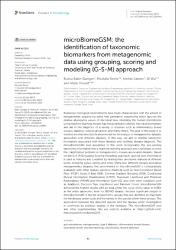| dc.contributor.author | Bakir-Gungor, Burcu | |
| dc.contributor.author | Temiz, Mustafa | |
| dc.contributor.author | Jabeer, Amhar | |
| dc.contributor.author | Wu, Di | |
| dc.contributor.author | Yousef, Malik | |
| dc.date.accessioned | 2024-01-12T08:00:47Z | |
| dc.date.available | 2024-01-12T08:00:47Z | |
| dc.date.issued | 2023 | en_US |
| dc.identifier.issn | 1664-302X | |
| dc.identifier.other | WOS:001117805800001 | |
| dc.identifier.uri | https://doi.org/10.3389/fmicb.2023.1264941 | |
| dc.identifier.uri | https://hdl.handle.net/20.500.12573/1891 | |
| dc.description.abstract | Numerous biological environments have been characterized with the advent of metagenomic sequencing using next generation sequencing which lays out the relative abundance values of microbial taxa. Modeling the human microbiome using machine learning models has the potential to identify microbial biomarkers and aid in the diagnosis of a variety of diseases such as inflammatory bowel disease, diabetes, colorectal cancer, and many others. The goal of this study is to develop an effective classification model for the analysis of metagenomic datasets associated with different diseases. In this way, we aim to identify taxonomic biomarkers associated with these diseases and facilitate disease diagnosis. The microBiomeGSM tool presented in this work incorporates the pre-existing taxonomy information into a machine learning approach and challenges to solve the classification problem in metagenomics disease-associated datasets. Based on the G-S-M (Grouping-Scoring-Modeling) approach, species level information is used as features and classified by relating their taxonomic features at different levels, including genus, family, and order. Using four different disease associated metagenomics datasets, the performance of microBiomeGSM is comparatively evaluated with other feature selection methods such as Fast Correlation Based Filter (FCBF), Select K Best (SKB), Extreme Gradient Boosting (XGB), Conditional Mutual Information Maximization (CMIM), Maximum Likelihood and Minimum Redundancy (MRMR) and Information Gain (IG), also with other classifiers such as AdaBoost, Decision Tree, LogitBoost and Random Forest. microBiomeGSM achieved the highest results with an Area under the curve (AUC) value of 0.98% at the order taxonomic level for IBDMD dataset. Another significant output of microBiomeGSM is the list of taxonomic groups that are identified as important for the disease under study and the names of the species within these groups. The association between the detected species and the disease under investigation is confirmed by previous studies in the literature. The microBiomeGSM tool and other supplementary files are publicly available at: https://github.com/malikyousef/microBiomeGSM. | en_US |
| dc.description.sponsorship | We extend our gratitude to COST ML4Microbiome Action
for the funding, which has played a pivotal role in advancing
microbiome research and facilitating the expansion of these
research endeavors. This research was made possible by the
generous support of the L’Oréal-UNESCO Young Women
Scientist Program. BB-G would like to express her gratitude for
the L’Oréal-UNESCO Young Women Scientist Award, received
in 2022. | en_US |
| dc.language.iso | eng | en_US |
| dc.publisher | FRONTIERS MEDIA SA | en_US |
| dc.relation.isversionof | 10.3389/fmicb.2023.1264941 | en_US |
| dc.rights | info:eu-repo/semantics/openAccess | en_US |
| dc.subject | gut microbiome | en_US |
| dc.subject | metagenomics | en_US |
| dc.subject | type 2 diabetes | en_US |
| dc.subject | inflammatory bowel disease | en_US |
| dc.subject | colorectal cancer | en_US |
| dc.subject | machine learning | en_US |
| dc.subject | classification | en_US |
| dc.subject | feature selection | en_US |
| dc.title | microBiomeGSM: the identification of taxonomic biomarkers from metagenomic data using grouping, scoring and modeling (G-S-M) approach | en_US |
| dc.type | article | en_US |
| dc.contributor.department | AGÜ, Mühendislik Fakültesi, Bilgisayar Mühendisliği Bölümü | en_US |
| dc.contributor.authorID | 0000-0002-2272-6270 | en_US |
| dc.contributor.authorID | 0000-0002-2839-1424 | en_US |
| dc.contributor.institutionauthor | Bakir-Gungor, Burcu | |
| dc.contributor.institutionauthor | Temiz, Mustafa | |
| dc.contributor.institutionauthor | Jabeer, Amhar | |
| dc.identifier.volume | 14 | en_US |
| dc.identifier.startpage | 1 | en_US |
| dc.identifier.endpage | 18 | en_US |
| dc.relation.journal | FRONTIERS IN MICROBIOLOGY | en_US |
| dc.relation.publicationcategory | Makale - Uluslararası Hakemli Dergi - Kurum Öğretim Elemanı | en_US |


















